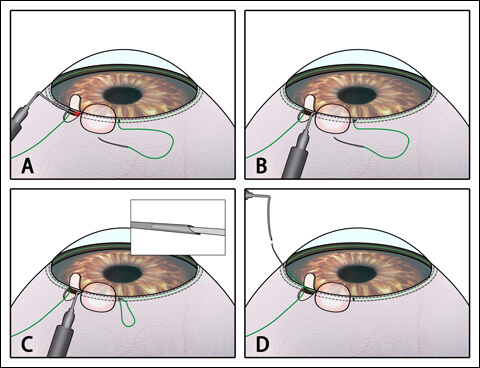Ab Externo Canaloplasty
New Glaucoma Treatment
Non-Penetrating. Lower IOP. Fewer Drops.
Canaloplasty. Lower IOP. Fewer Drops.
Do you suffer from open angle glaucoma? Drops not working? Do you find it difficult to afford your medications or do they give you bothersome side effects? Canaloplasty is a newer, safer surgical treatment, which has been successfully helping many glaucoma patients worldwide control their eye pressure (IOP) – many, who after surgery, no longer need their eye drops!
What is Canaloplasty
Canaloplasty is an advanced “non-penetrating” glaucoma surgery which means it does not require creation of a hole in the eye (fistula) nor does it result in a “bleb” (blister) as required with the more traditional glaucoma surgery called trabeculectomy (“trab” for short).
Essentially, this surgery is like angioplasty for the eye as it uses a breakthrough microcatheter technology to restore the function of the eye’s natural outflow system. This gives canaloplasty an excellent safety profile, with early eye pressure stability after surgery and faster recovery time. It also means less activity restrictions and post-operative visits for patients when compared to trabeculectomy.
As glaucoma can cause a permanent loss of vision, this procedure can provide patients with glaucoma a “peace of mind” not possible with use of glaucoma drops alone. Canaloplasty can reduce eye pressure by nearly 40%, and most glaucoma patients who have had Canaloplasty can cut their glaucoma drops in half. In some cases, Canaloplasty can even eliminate the need for Glaucoma drops.
How Long Has Canaloplasty Been Around?
The FDA has approved the Canaloplasty procedure since 2008. But the surgery itself is actually based on a surgery called viscocanalostomy that has been around since 1990. This procedure was first described by Dr. Stegman and has since become quite popular in places such as South Africa, Europe and part of the reason for that is that, it has a good track record of success itself albeit its very challenging technical difficulty. Seven year results are out and those results look very good with many people having a sustained reduction in their pressure of up to 30%. It was not until recently that iScience (now, Ellex Medical) created the iTrack catheter, which enables surgeons to effectively viscodilate the Schlemm’s canal, that really revolutionized viscocanalostomy and turned it into the highly effective and easier to perform canaloplasty.
How Is Canaloplasty Performed?
Canaloplasty uses a micro-catheter to open the eye’s natural drainage system (“Schlemm’s canal”). This canal is then opened using a sterile, gel-like material (“viscoelastic”). The iTrack® micro-catheter is then removed while a suture is threaded through Schlemm’s canal. The suture is then tied down resulting in tension on the the inner wall of the canal – just as you might pull on the strings of a “hoodie” to close the hood over your face. The suture placed in the eye’s drainage canal can keep the canal stretched open for years. Once this canal is opened, the eye’s fluid can exit through a more natural process allowing the pressure in the eye to drop to a more normal level.
[Video courtesy of Ellex Medical]
Why Canaloplasty Glaucoma Surgery?
- It uses the eye’s natural drainage system
- It is a “non-penetrating” procedure that does not create a permanent fistula in the wall of the eye and does not require a bleb (a blister-like fluid collection)
- Provides long-term reduction in IOP (see three year results below)
- Reduces the need for medications to keep the IOP controlled
- Is a good option for those patients who are not yet ready for more trabeculectomy or tube shunts
- Is safer than traditional glaucoma surgeries (Canaloplasty vs Trabeculectomy)
STUDIO CITY (KCAL9) — Dr. Richardson visited the KCAL9 studios to talk about Glaucoma and a new surgery he is offering to patients. The FDA recently approved a procedure called “Canaloplasty,” which is a sight-saving, breakthrough surgery for those who suffer from the disease.

Canaloplasty is Pro-Active Lifestyle
If you are an energetic person who enjoys such activities as watersports, it is important for you to know that having traditional glaucoma surgery will severely limit your ability to participate in certain sports. No such limitation exists with Canaloplasty. Once healed, patients who have had Canaloplasty are able to return to their previous active lifestyles without restriction or limitation.

EFFICACY: How Effective Is Canaloplasty?
Canaloplasty Is Effective
Canaloplasty showed very impressive results in the published 3 Year Clinical Study. The number of medications required to keep the IOP under control was reduced by 53% … this sustained reduction in drops used means that the cost of canaloplasty could easily be paid just with the cost savings from using fewer medications to control IOP. The reduction in intraocular pressure (IOP) after canaloplasty was 34% – this was the lowest average IOP! The IOP in those patients who underwent Phacocanaloplasty™ was reduced by almost half (42%)! 88% of patients achieved IOP control without drops three years after canaloplasty!

SAFETY: How Safe Is Canaloplasty?
Canaloplasty Is Safer
Studies which compared the results of Canaloplasty vs. trabeculectomy (the traditional glaucoma surgical treatment) showed that Canaloplasty patients experienced fewer side effects and complications compared to those who had trabeculectomy. And patients who had Canaloplasty had better vision than those patients who had trabeculectomy. For those who are candidates for Canaloplasty, it offers greater safety over trabeculectomy with similar benefits.

Canaloplasty Has Helped Many Glaucoma Patients
These are just a few testimonials out of over 60,000 canaloplasty procedures done worldwide!
Canaloplasty Surgery on Both Eyes
Canaloplasty versus Trabeculectomy
Canaloplasty After Trabeculectomy
So I said, “Well we know about me, I don’t like drops, I don’t do them well, laser didn’t work. Can we go right to canaloplasty on the left eye?” And that’s exactly what we did. All in all it was absolutely the right decision, for me. Given who I was, my lifestyle, the way I work, and what I wanted. So it’s an excellent result…It was absolutely the right decision.
My first expression when it was over was that “It was a piece of cake!” And I would recommend it to people because I think it was very successful and the biggest part about it, aside from not losing anymore eyesight, I don’t have to take drops four and five times a day. Four and five drops, four and five times a day. So I was very happy with that outcome also.
There are a lot of costs involved when it comes to travelling all the way from India and then coming here. But seeing the plus points in terms of …physical activities… And seeing that I don’t have to undergo lifestyle modification it’s (cost) hardly anything. And I don’t regret the decision of coming here and getting the surgery done – at all.I’m truly very happy.
So I checked around and canaloplasty came up… (Duke Eye Center)—mentioned canaloplasty. And I called up another friend of mine who is a chair of UC Irvine and he recommended the same thing….
April 20, 2012 | Chicago, IL – Dr. Robert Sinkey was interviewed by Dr. David Richardson at an iScience didactic course during the American Society of Cataract and Refractive Surgery (ASCRS) 2012 annual meeting. Dr. Sinskey discussed his glaucoma diagnosis, treatment and decision to have Canaloplasty as well as the subsequent outcomes of the procedure.
Who Is a Candidate For Canaloplasty Surgery?
Most anyone with open angle glaucoma that requires treatment is a candidate for Canaloplasty.
Canaloplasty is also suitable for the following:
- Pigmentary Glaucoma (PG)
- Pseudoexfoliation Glaucoma (PXF)
- Ocular Hypertension
- Normal Tension Glaucoma (NTG)
- Juvenile Glaucoma
- Steroid Induced Glaucoma
- Patients Post-SLT
- Patients Post single session low power ALT
- Patients with previous failed trabeculectomy or tube surgery in which Schlemm’s canal has been left undamaged from previous filtrating surgeries.
- Patients who can’t keep up with Drops Regimen – a hassle and/or too costly
What Top Glaucoma Surgeons Are Saying
Canaloplasty Is Preferred by Some of the World’s
Most Respected Eye Surgeons

Canaloplasty is a new surgical technique for the treatment of glaucoma. This method is now already in use at many University Eye Hospital and private clinics. The process is gentle to the patient – through the improvement and restoration of the natural drainage system in the eye to reduce intraocular pressure. As a result, the dangerous pressure peaks in the eye can be prevented and patients need less or no glaucoma eyedrops anymore to regulate intraocular pressure. Compared to conventional glaucoma surgery, there is potentially lower risk, reduced scarring and future treatment alternatives are not ruled out
Canaloplasty is a desirable option for glaucoma patients because it decreases the number of necessary post-operative visits and there are fewer complications to treat. As an added bonus, patients save thousands of dollars in the cost of medications because canaloplasty reduces the amount of medication patients need in order to control the IOP. The ultimate result? A happier patient who can go back to enjoying life without restrictions.

LATEST ARTICLES ON DR. RICHARDSON’S GLAUCOMA HEALTHHUB
See If Canaloplasty Is for You
David D. Richardson, MD, is a board-certified Ophthalmologist specializing in the treatment of cataract and glaucoma. He is also recognized as one of the most highly skilled cataract and glaucoma surgeons in the US and is among an elite group of glaucoma surgeons in the country performing the highly specialized, minimally-invasive glaucoma surgery (MIGS), canaloplasty.
Call today to schedule an appointment with Dr. Richardson at
(626) 289 7856




